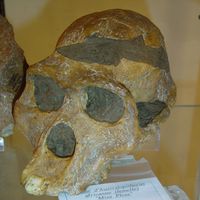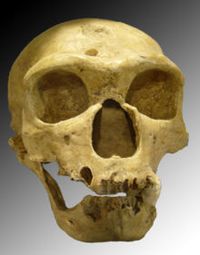إنسان فلوريس
| إنسان فلوريس | |
|---|---|
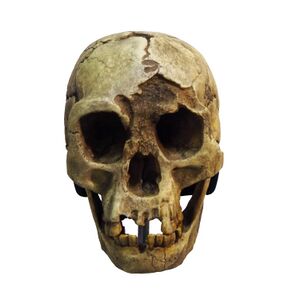
| |
| H. floresiensis skull, Cantonal Museum of Geology, Switzerland | |
| التصنيف العلمي | |
| أصنوفة غير معروفة (أصلحها): | الحياة |
| مملكة: | الحيوانية |
| Phylum: | حبليات |
| Class: | الثدييات |
| تحت رتبة: | جافة الأنف |
| فوق رتبة: | القرديات |
| الجنس: | هومو |
| Species: | †H. floresiensis
|
| Binomial name | |
| †Homo floresiensis Brown et al., 2004
| |
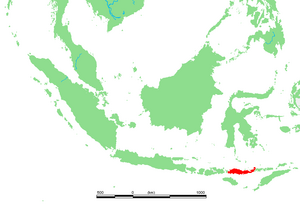
| |
| Flores in Indonesia, shown highlighted in red | |
Homo floresiensis (النطق: []flɔːrˈɛziːˌɛn.sɪs[]), also known as "Flores Man" or "Hobbit" (after the fictional species), is an extinct species of small archaic humans that inhabited the island of Flores, Indonesia, until the arrival of modern humans about 50,000 years ago.
The remains of an individual who would have stood about 1.1 m (3 ft 7 in) in height were discovered in 2003 at Liang Bua cave. As of 2015, partial skeletons of 15 individuals have been recovered; this includes one complete skull, referred to as "LB1".[1][2]
Homo floresiensis is thought to have arrived on Flores around 1.27–1 million years ago.[3][4] There is debate as to whether H. floresiensis represents a descendant of Javanese Homo erectus that reduced its body size as a result of insular dwarfism, or whether it represents an otherwise undetected migration of small, Australopithecus or Homo habilis-grade archaic humans outside of Africa.[5]
This hominin was at first considered remarkable for its survival until relatively recent times, initially thought to be only 12,000 years ago.[6] However, more extensive stratigraphic and chronological work has pushed the dating of the most recent evidence of its existence back to 50,000 years ago.[7][8][9] The Homo floresiensis skeletal material at Liang Bua is now dated from 60,000 to 100,000 years ago; stone tools recovered alongside the skeletal remains were from archaeological horizons ranging from 50,000 to 190,000 years ago.[7] Other earlier remains from Mata Menge date to around 700,000 years ago.[10]
Specimens
Discovery
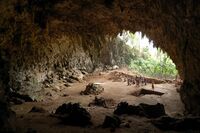
The first specimens were discovered on the Indonesian island of Flores on 2 September 2003 by a joint Australian-Indonesian team of archaeologists looking for evidence of the original human migration of modern humans from Asia to Australia.[1][6] They instead recovered a nearly complete, small-statured skeleton, LB1, in the Liang Bua cave, and subsequent excavations in 2003 and 2004 recovered seven additional skeletons, initially dated from 38,000 to 13,000 years ago.[2]
In 2004, a separate species Homo floresiensis was named and described by Peter Brown et al., with LB1 as the holotype. A tooth, LB2, was referred to the species.[1] LB1 is a fairly complete skeleton, including a nearly complete skull, which belonged to a 30-year-old woman, and has been nicknamed "Little Lady of Flores" or "Flo".[1][11] An arm bone provisionally assigned to H. floresiensis, specimen LB3, is about 74,000 years old. The specimens are not fossilized and have been described as having "the consistency of wet blotting paper". Once exposed, the bones had to be left to dry before they could be dug up.[12][13] The discoverers proposed that a variety of features, both primitive and derived, identify these individuals as belonging to a new species.[1][6] Based on previous date estimates, the discoverers also proposed that H. floresiensis lived contemporaneously with modern humans on Flores.[14] Before publication, the discoverers were considering placing LB1 into her own genus, Sundanthropus floresianus (حرفياً 'Sunda human from Flores'); however, reviewers of the article recommended that, despite her size, she should be placed in the genus Homo.[15]

In 2009, additional finds were reported, increasing the minimum number of individuals represented by bones to fourteen.[16] In 2015, teeth were referred to a fifteenth individual, LB15.[17][18]
Stone implements of a size considered appropriate to these small humans are also widely present in the cave. The implements are at horizons initially dated to 95,000 to 13,000 years ago.[2] Modern humans reached the region by around 50,000 years ago, by which time H. floresiensis is thought to have become extinct.[7] Comparisons of the stone artifacts with those made by modern humans in East Timor indicate many technological similarities.[19]
Scandal over specimen damage
The fossils are property of the Indonesian state. In early December 2004, Indonesian paleoanthropologist Teuku Jacob, formerly chief paleontologist of the Indonesian Gadjah Mada University, removed most of the remains from their repository at Jakarta's National Research Centre of Archaeology with the permission of Raden Panji Soejono, one of the institute's directors. He kept the bones for three months.[20][21][22][23]
Professor Jacob had previously stated that he did not believe the specimens represented a different species, and claimed that the LB1 find was from a 25–30 year-old member of a omnivorous subspecies of H. sapiens; further speculating that it probably was a pygmy and that the size of its skull was even so much more small due to pathological microcephaly, which produces a small brain and skull.
Professor Richard Roberts of the University of Wollongong in Australia and other anthropologists objected to this withholding of the evidence by an individual with self-proclaimed bias against contrary research investigating support for a new species of Homo, saying they feared that important scientific evidence would be sequestered by a small group of scientists who neither allowed access by other scientists nor published their own research.[21] Jacob returned the remains on 23 February 2005 with portions severely damaged[24] and missing two leg bones.[25]
Press reports thus described the condition of the returned remains:
- "[including] long, deep cuts marking the lower edge of the Hobbit's jaw on both sides, said to be caused by a knife used to cut away the rubber mould ... the chin of a second Hobbit jaw was snapped off and glued back together. Whoever was responsible misaligned the pieces and put them at an incorrect angle ... The pelvis was smashed, destroying details that reveal body shape, gait and evolutionary history.",[26]
causing the discovery team leader Morwood to remark,
- "It's sickening; Jacob was greedy and acted totally irresponsibly."[24]
Jacob, however, denied any wrongdoing. He stated that the damages occurred during transport from Yogyakarta back to Jakarta[26][27] despite the reported contrary physical evidence that the jawbone had been broken while making a mould of the bones.[24][28]
In 2005, Indonesian officials forbade access to the cave. Some news media, such as the BBC, expressed the opinion that the restriction was to protect Jacob, who was considered "Indonesia's king of palaeoanthropology", from being proved wrong. Scientists were allowed to return to the cave in 2007, shortly after Jacob's death.[26]
Classification and evolution
−10 — – −9 — – −8 — – −7 — – −6 — – −5 — – −4 — – −3 — – −2 — – −1 — – 0 — |
| |||||||||||||||||||
Phylogeny and evolution
Because of the deep neighbouring Lombok Strait, Flores remained an isolated island during episodes of low sea level. Therefore, the ancestors of H. floresiensis could only have reached the island by oceanic dispersal, most likely by rafting.[29] The oldest stone tools on Flores are around 1 million years old.[3][4] Stone artifacts are absent from sites over 1.27 million years old, suggesting that the ancestors of H. floresiensis arrived after this time.[4]
In 2016, fossil teeth and a partial jaw from hominins assumed to be ancestral to H. floresiensis were discovered at Mata Menge, about 74 km (46 mi) from Liang Bua. They date to about 700,000 years ago. Other remains (including a humerus) were later described from Mata Menge, with the remains subsequently being directly assigned to H. floresiensis. These remains are about the same size or somewhat smaller than the remains from Liang Bua, suggesting the size of the species remained stable for hundreds of thousands of years up until its extinction.[30][31][32][10]
Two hypotheses have been proposed as to the origin of H. floresiensis. The first proposes that H. floresiensis descended from an early migration of very primitive small Australopithecus/Homo habilis-grade archaic humans outside of Africa prior to 1.75 million years ago. This is based on various aspects of H. floresiensis sketetal anatomy, such as its feet bones[33] being considered as more similar to those of very archaic humans such as Australopithecus and Homo habilis than to Homo erectus.[33][34][35][36][37] This position has been supported by several cladistical analyses.[34][35][36][37][38] Other authors have argued that H. floresiensis instead likely represents the descendants of a population of Javanese Homo erectus that became isolated on Flores, with the small body size being the result of insular dwarfism, a well known evolutionary trend found among various island animals.[39][40][41][5][42] These authors alternatively suggest that H. floresiensis has several cranial and dental similarities to H. erectus, particularly to early Javanese Homo erectus.[40][41][5][43][42] These authors also dispute some of the similarities to Australopithecus and Homo habilis-grade archaic humans,[10] and suggest that others may have been the result of evolutionary reversals/convergence.[5]
It has been noted that there is no evidence of archaic humans in the adjacent (and likely source) region of Java earlier than 1.3-1.5[44] or 1.8 million[45] years ago, with the earliest human presence on Java being represented by Homo erectus.[10] There is also no evidence of Australopithecus or Homo habilis-grade archaic humans anywhere outside of Africa, which supporters of the Homo erectus-origin hypothesis suggest makes the descent of H. floresiensis from these more primitive hominins unlikely.[10][5]
DNA extraction attempt
In 2006, two teams attempted to extract DNA from a tooth discovered in 2003; however, both teams were unsuccessful. It has been suggested that this happened because the dentine was targeted; new research suggests that the cementum has higher concentrations of DNA. Moreover, the heat generated by the high speed of the drill bit may have denatured the DNA.[46]
Congenital disorder claims
The small brain size of H. floresiensis at 417 cc prompted hypotheses that the specimens were simply H. sapiens with a birth defect, rather than the result of neurological reorganisation.[47] These claims have subsequently been widely rejected.[5]
Microcephaly
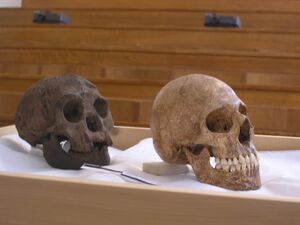
Prior to Jacob's removal of the fossils, American neuroanthropologist Dean Falk and her colleagues performed a CT scan of the LB1 skull and a virtual endocast, and concluded that the brainpan was neither that of a pygmy nor an individual with a malformed skull and brain.[48] In response, American neurologist Jochen Weber and colleagues compared the computer model skull with microcephalic human skulls, and found that the skull size of LB1 falls in the middle of the size range of the human samples, and is not inconsistent with microcephaly.[49][50] A 2006 study stated that LB1 probably descended from a pygmy population of modern humans, but herself shows signs of microcephaly, and other specimens from the cave show small stature but not microcephaly.[51]
In 2005, the original discoverers of H. floresiensis, after unearthing more specimens, countered that the skeptics had mistakenly attributed the height of H. floresiensis to microcephaly.[2] Falk stated that Martin's assertions were unsubstantiated. In 2006, Australian palaeoanthropologist Debbie Argue and colleagues also concluded that the finds are indeed a new species.[52] In 2007, Falk found that H. floresiensis brains were similar in shape to modern humans, and the frontal and temporal lobes were well-developed, which would not have been the case were they microcephalic.[53]
In 2008, Greek palaeontologist George Lyras and colleagues said that LB1 falls outside the range of variation for human microcephalic skulls.[54] However, a 2013 comparison of the LB1 endocast to a set of 100 normocephalic and 17 microcephalic endocasts showed that there is a wide variation in microcephalic brain shape ratios and that in these ratios the group as such is not clearly distinct from normocephalics. The LB1 brain shape nevertheless aligns slightly better with the microcephalic sample, with the shape at the extreme edge of the normocephalic group.[55] A 2016 pathological analysis of LB1's skull revealed no pathologies nor evidence of microcephaly, and concluded that LB1 is a separate species.[56]
Laron syndrome
A 2007 study postulated that the skeletons were those of humans who suffered from Laron syndrome, which was first reported in 1966, and is most common in inbreeding populations, which may have been the scenario on the small island. It causes a short stature and small skull, and many conditions seen in Laron syndrome patients are also exhibited in H. floresiensis. The estimated height of LB1 is at the lower end of the average for afflicted human women, but the endocranial volume is much smaller than anything exhibited in Laron syndrome patients. DNA analysis would be required to support this theory.[57]
Congenital iodine deficiency syndrome
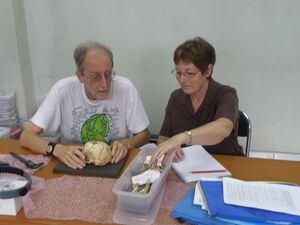
In 2008, Australian researcher Peter Obendorf — who studies congenital iodine deficiency syndrome — and colleagues suggested that LB1 and LB6 suffered from myxoedematous (ME) congenital iodine deficiency syndrome resulting from congenital hypothyroidism (underactive thyroid), and that they were part of an affected population of H. sapiens on the island. Congenital iodine deficiency syndrome, caused by iodine deficiency, is expressed by small bodies and reduced brain size (but ME causes less motor and mental disablement than other forms of congenital iodine deficiency syndrome), and is a form of dwarfism still found in the local Indonesian population. They said that various features of H. floresiensis are diagnostic characteristics, such as enlarged pituitary fossa, unusually straight and untwisted humeral heads, relatively thick limbs, double rooted premolar, and primitive wrist morphology.[58]
However, Falk's scans of LB1's pituitary fossa show that it is not larger than usual.[59] Also, in 2009, anthropologists Colin Groves and Catharine FitzGerald compared the Flores bones with those of ten people who had had cretinism, and found no overlap.[60][61] Obendorf and colleagues rejected Groves and FitzGerald's argument the following year.[62] A 2012 study similar to Groves and FitzGeralds' also found no evidence of congenital iodine deficiency syndrome.[63]
Down syndrome
From 2006, physical anthropologist Maciej Henneberg and colleagues have claimed that LB1 suffered from Down syndrome, and that the remains of other individuals at the Flores site were merely normal modern humans.[64] However, there are a number of characteristics shared by both LB1 and LB6 as well as other known early humans and absent in H. sapiens, such as the lack of a chin.[65] In 2016, a comparative study concluded that LB1 did not exhibit a sufficient number of Down syndrome characteristics to support a diagnosis.[66] The noted physical anthropologist Chris Stringer in 2011 wrote of Homo floresiensis deniers generally, "I think they have damaged their own, and palaeoanthropology's, reputation".[67]
تاريخه
وكان أقدم جنس للإنسان البدائي هو أسترالوبيثكس : Australopithecus. و جسمه كان قصيرا ونحيل الوزن و مخه أصغر وفكه كبير وجبهته مسحوبة . و أسنانه وسقف حلقه يشبهان سنة وحلق سقف القرد. و يسير منتصبا. وكان قادرا علي صنع أدواته البدائية . وقد عثر علي عظامه قرب بحيرة تشاد بأفريقيا .و عبيدية في فلسطين . ويرجع عمره إلي 2,5 مليون سنة . وأقدم حفائره ما تم العثور عليه في منطقة كوبي في كينيا ويرجع عمرها إلي 2,6مليون سنة وحفائر وادي أومو في إثيوبيا ويرجع عمرها إلي 3مليون سنة .
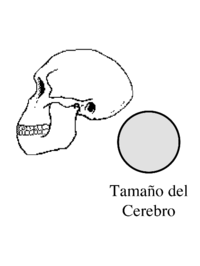
وكان الإنسان الأول قد صنع آلاته الحجرية والمكاشط والأسلحة . وفي فجر العصر الحجري كان يوجد نوعان من أسلاف البشر من جنس هومو (genus Homo) و جنس أوسترالوبيثكس genus Australopithecus) . لكن الإنسان قد تطور فيما بعد لأشكال أخري من هومو من بينها الإنسان الماهر( الصانع) Homo habilis والإنسان المنتصب Homo erectus و إنسان نيندرتال Homo neanderthalensis . وآخرهم الإنسان العاقل Homo sapiens الذي يعتبر حاليا جد الإنسان الحديث المعاصر . وكان اكتشاف إنسان نيندرتال عام 1856 أول صيحة تصلنا من أغوار الزمن السحيق. لأن أول إنسان انتصبت قامته ووقف علي قدميه كان منذ 3, 6مليون سنة. حيث اكتشفت عظامه في لاتوالي بتانزانيا . ثم ظهر الإنسان العاقل منذ 3مليون سنة . واكتشفت جمجمة طفل توانج في جنوب أفريقيا وعمرها 2,5 مليون سنة . ثم اكتشفت عائلة لوسي بمنطقة حيدار في أثيوبيا . وهي من جنس إنسان أفريانس الذي عثر علي بصمات أقدامه بشمال تانزانيا وعمرها 3,5 مليون سنة. . واكتشفت عائلة أشباه الإنسان وعمرها 4,4 مليون سنة . وأطلق عليها هومو أسترالوبيثكس راميدس . وهو همزة الوصل بين الإنسان والشمبانزي . وقد صنع أدواته الحجرية الحادة وشفرات لتقطيع اللحوم بجوانا بأثيوبيا .

وفي إندونيسيا حيث يعيش الإنسان الحديث ، كانت جزيرة فلوريس مصدر أساطير شعبية عن كائنات بشرية غريبة تعيش هناك . وكلها كانت من الأقزام. وكانت تروي عنهم الحكايات الغريبة وتنسج حولهم المقولات المثيرة بعد اكتشاف سبعة من نوع الإنسان القزم. وهذا الخبر المثير للجدل حول أصول الإنسان الحديث . وضع عدة أسئلة حول شجرة الإنسان وتطوره فوق الأرض. لكن ما زاد علماء الإنسان حيرة أن هذا الإنسان القزمي الذي كان يعيش قي إندونيسيا كان وجوده متزامنا مع وجود الإنسان الحديث حتي 12 ألف سنة . فما هي قصة هذا الإنسان الذي أنقرض من دنيانا ؟ . والذي أطلق عليه إنسان فلوريس, Flores Man اوهومو فلورسينسيز Homo floresiensis وانضم للأسرة البشرية مؤخرا بعد اكتشافه المثير . واعتبر كأحد أسلاف الإنسان الذين عاشوا فوق الأرض ولاسيما وأن هذه المخلوقات كانت تتسم بالذكاء والإبداع وقد أوردت تفاصيل الاكتشاف المثير مجلة نيتشر (الطبيعة).
في أكتوبر ا لماضي كان اكتشاف الرجل القرد apeman أو "hobbits" وهو نوع جديد من البشر يعتبر أهم حدث في علم الإنسان anthropology خلال قرن. حيث عاش بجانب إنسان ما قبل التاريخ لآلاف السنين ، وانقرض في غابات إندونيسيا الكثيفة في عالم مفقود كان يسكنه الأفيال القزمية والفئران العملاقة . وكان فريق من علماء الآثار الأستراليين ينقبون في المنطقة ضمن تفتيشهم لكهف في جزيرة فلوريس الإندونيسية الغنية ببقايا الحيوانات كالسحالي العملاقة والوحوش المتحفية المصغرة .ولأول وهلة ظن الباحثون أن الهيكل العظمي لطفل . لكن الجمجمة كانت عظامها مغلقة .ومن أسنانها عرفوا أنها في سن الثلاثين عندما ماتت . وكانوا قد عثروا علي بقايا 7 أشخاص بالمنطقة بعضهم يرجع إلي 13 ألف سنة. مما يدل علي أن هذا النوع كان يعيش فوق هذه الجزيرة البركانية. وكان لا يشاركهم فيها أي نوع آخر من بني البشرأسلافنا في نفس الوقت .وهذا ما جعل عالم الحيوان البريطاني ريتشارد دوكينز من جامعة أكسفورد وأستاذ الاستنتاج العلمي scientific understanding يقول : هذا الاكتشاف الذي يعد أكثر إثارة في علم الإنثربولوجيا ( علم الإنسان ) لعقود
و العينة التي اكتشفت مؤخرا عمرها الحياتي 4 سنوات ووزنها 25 كجم .ومخ هؤلاء الأقزام أقل من مخ الشمبانزي . لمنهم كانوا يستعملون النار. وقد صنعوا أدوات حجرية واصطادوا حيوان الإستجودون STEGODON ( فيل بدائي) والفئران العملاقة . ويعتقد أنهم قد وفدوا للجزيرة في قوارب بالذكاء.ؤلاء الأقزام كان لهم لغتهم ويتمتعون بالذكاء .ومن الناحية التشريحية وجد أن امرأة فلوريس سعة مخها 380 سم مكعب ، وهو ثلث حجم الإنسان الحديث ونصف حجم الإنسان المنتصب من الجنس العاقل . وكان علماء الآثار الأستراليون قد عثروا ضمن تنقيبهم على عظام للإنسان القزم في منطقة تدعى (ليانج بو) التي تضم بعضا من الكهوف الجيرية العديدة في جزيرة فلوريس. حيث تم العثور على بقايا أجزاء من هيكل عظمي على عمق 5.9 مترا بكهف Liang Bua ، و ظنوا أنها عظام طفل .لكن علامات التآكل على الأسنان وخطوط النمو في عظام الجمجمة أكدت أن الهيكل عمره 18 ألف سنة.و يعود لشخص بالغ . وبينت خصائص عظام الحوض أنه لأنثى أطلق عليها هوبت "hobbit" ، ومن عظم الساق نجدها كانت تسير منتصبة وهو ما يميز الإنسان عن القرد . و علق مايك مورود أستاذ علم الآثار بجامعة نيو إنجلاند في أستراليا قائلا "حينما تلقينا النتائج الخاصة بالعمر الزمني لتحليل الهيكل العظمي، وجد أنه يرجع لإنسان حديث العهد. لكن بعض العلماء قالوا بان هذه النتائج خاطئة ولاسيما وانه يحمل الكثير من الخصائص البدائية القديمة ويرجع تاريخه إلى 18 ألف سنة . وصنف على أنه نوع إنسان فلوريس "هومو فلوريسينسيس". وكان طوله مترا واحدا و له أذرع طويلة وحجم جمجمته يماثل حجم ثمرة (جريب فروت) كبيرة .ويعد اكتشافه تم العثور على بقايا ستة أجزاء هياكل أفراد آخرين من نفس النوع. واكتشاف جزء من هيكل امرأة فلوريس في كهف ليانج بوا الجيري وغيره ، برهان علي أن الكهف كان مأهولا لمدة 800 ألف سنة. حيث وجد الباحثون أدوات حجرية تشبه ما عثر عليه في مواقع أخري من العالم للإنسان المنتصب. لكنها أقل حجما .وكانت جزيرة فلوريس قد عانت من كارثة انفجار بركاني منذ 12 ألف سنة . بعده ل ايوجد أثر لإنسان فلوريس .ويتوقع العلماء اكتشاف أنواع جديدة من بني الإنسان في الجزر المجاورة لجزيرة فلوريس .لأن هذه الجزر كانت منعزلة عن بعضها . وتعتبر كلها من نسل الإنسان المنتصب الذي كان له مخا كبيرا ومكتمل الجسم. وانتشر من أفريقيا لآسيا منذ 3 مليون سنة.
واكتشاف الالإنسان لماته فوق جزيرة فلوريس الاستوائية المنعزلة كان غير متوقع .لأن علماء الإنسان لم يعرفوا أي حيوان أرضي في هذا الزمن من قبل, عير البحر ليصل الجزرفيه. إندونيسيا.لأن البشر لم يكونوا في هذا الوقت قد نمو نموا كافيا بحيث يمكنهم بناء قارب والإبحار فيه . فلو كان الإنسان المنتصب قد بلغ جزيرة فلوريس وتولد منه إنسان فلوريس, فهذا معناه أنه بلغ جزر أخري . وتولد منه أنواع بشرية أخري بهذه الجزر . ولاسيما ما يروي من الأساطير عن أقزام عاشت فوق الجزر الشرقية قديما بجنوبي شرق آسيا. وكان إنسان فلوريس قد عاش على جزيرته في نفس الوقت الذي عاشت عليها فئران صفراء بحجم الكلب الصغير، وسلاحف عملاقة وسحالي ضخمة - منها نوع الكومودو الضخم - فضلا عن الفيل القزم (ستيجودون) وهو في حجم حصان (السيسي) وكان إنسان فلوريس يصطادها. ويعتبر طول الذراعين من الخصائص المثيرة للجدل حوله. فالدراسات حول يديه وقدميه قد تلقي الضوء على أنه تطور من نوع "هومو إركتوس" ( الإنسان المنتصب)، الذي تم العثور على بقاياه في جزيرة جاوة الإندونيسية. ويرجح العلماء أن الإنسان القزم قد جاء إلى جزيرة فلوريس قبل نحو مليون سنة . وتطورت قامته القصيرة بسبب العزلة التي كانت مفروضة عليه من بيئة جزيرة فلوريس .وهذا النوع البشري وصل إليها عن طريق القوارب. و مازال سكانها يذكرون هذه الخلائق الأسطورية ضمن مرويا تهم التراثية الشعبية. فيروون عنهم الحكايات حيث أطلقوا عليهم (إيبو جوجو) .ووصفوهم بقصر الطول و كثافة الشعر وكانوا يتمتمون لبعضهم بما يشبه اللغة الشفهية.
و آخِر الأدلة على وجود هذا النوع من إنسان فلوريس يرجع تاريخه إلى قبل 12 ألف سنة حيث تسببت ثورة بركانية في القضاء على أغلب صور الحياة البرية بالجزيرة. لكن الأساطير تقول إن أقزام فلوريس كانت موجودة عندما وصل المستكشفون الهولنديون منذ عدة قرون إلى الجزر الإندونيسية. ومن بينها أسطورة تعود إلى نحو 100 سنة. مما يدل علي أن أنواعا تشبه إنسان فلوريس قد ظلت على قيد الحياة، في مكان ما بعمق الغابات الإندونيسية الشاسعة والمجهولة حاليا .وهذا الاكتشاف لاشك سيعيد كتابة تاريخ التطور البشري .وربما تطور صغر قامته التي يرجح العلماء أنها كانت بسبب ندرة الموارد على الجزيرة. لأنه من المعروف حينما تتقطع السبل بالكائنات على جزر ما ، فإنها تتطور بأشكال جديدة لا يمكن التنبؤ بها. فقد يصبح بعضها عملاقا, بينما قد يصبح الآخرون أقزاما. ومما أثار دهشة علماء الآثار الأدوات الحجرية المعقدة التي وجدت بجانب هياكل الإنسان القزم رغم صغر حجم مخه . فهذا الاكتشاف يتعارض مع فكرة شرط حجم معين للمخ للقيام بأي عمل يتسم بالذكاء. وتعد بقايا هذه الهياكل حديثة نسبيا . ولاسيما وإنها لم تتحول إلى حفريات، ولو أستطاع العلماء استخلاص الحامض النووي (DNA)، فإنهم سيستطيعون تقديم منظورا جديدا عن تطور السلالات البشرية. كما فعلوا مع إنسان نيندرتال عندما حصلوا علي نتائج تحاليل عينات نووية من هياكله العظمية . فلم يتمكنوا من الوصول إلي دليل على أن إنسان النيندرتال قد تزاوج مع الإنسان الحديث في أي مرحلة سابقة. وكانت هذه النظرية موضع جدل بين العلماء . وكانت عينات الحامض الوراثي (النووي) قد أخذت من بقايا إنسان النيندرتال التي عُثر عليها بكهف فينديا في كرواتيا, ومن بقايا عثر عليها في كهف فيلهوفر في ألمانيا ،وبقايا طفل نيندرتالي عثر عليه في كهف مزمياسكايا في شمال القوقاز . وكان العلماء قد قاموا في معهد ماكس بلانكس للتطور الوراثي في ليبزيج بألمانيا بمقارنة الحامض النووي (الوراثي) للنيندرتال بالحوامض النووية الوراثية للإنسان والقرود والغوريلا. ويقول سافانتي بابو أستاذ علم الوراثة والتطور ورئيس فريق البحث : إن هذه الاختبارات سوف تمكن العلماء من معرفة حجم التنوع الوراثي الموجود بين أنواع النيندرتال .أو هل هو كالإنسان الحديث . حيث لا توجد بين أنواعه اختلافات وراثية شديدة؟ .أم هناك اختلافات كبيرة بين أنواعه كما في الشمبانزي وباقي أنواع القرود؟ . لكن النتائج تبين أن النياندرتال كالإنسان الحالي من حيث قلة تنوعه الوراثي، عكس القرود التي تتميز بتنوع وراثي كبير. فقد يكون تكاثره من أعداد قليلة ، كما كان مع الإنسان المعاصر. وهذه الاختبارات للأحماض الوراثية بينت أن النيندرتال يختلف عن الإنسان المعاصر ، لأنه من الناحية الوراثية بعيد عن الإنسان الأوروبي وعن الإنسان الأفريقي. رغم أن هذه الاختبارات الوراثية قد تحل اللغز القديم الذي يدور حول احتمال وقوع تزاوج تاريخي بين الإنسان الحديث والنيندرتال . لكن النتائج التي توصل إليها فريق البحث لم تستدل علي مثل هذا التزاوج.وكانت عائلة إنسان النيندرتال قد عاشت في أوروبا قبل 130ألف سنة إلي 30ألف سنة.لكن التنوع الوراثي للنيندرتال يدل علي أن عدد أفراده كانت تناقص في بعض المراحل التاريخية . ربما بسبب تغير في المناخ حيث لم يتمكن من التغلب على الظروف المناخية التي تعرض لها .فانقرض كليا لسلل قلة الأعداد التي عاشت في المراحل التاريخية المختلفة ،عكس الإنسان الحالي.
واكتشاف نوع الإنسان في جنوب شرق آسيا قد أخذ يمارس الفلاحة منذ 10 آلاف سنة, بعني انه قد عاصر الإنسان الحديث طوال 40 ألف سنة. مما يضفي تفسيرات حول تطور الإنسان.لأن شجرة نسب الإنسان التي تضم أصول البشر وأشباه البشر تبين أن الإنسان أصله الشمبانزي الذي عاش منذ 7 مليون سنة وانقرض منذ 2 مليون سنة . لكن الإنسان القزم كان ظهوره في مرحلة متأخرة نسبيا ،بسبب البيئة المنعزلة ونقص الطعام وقلة تعرضه للمفترسين في جزيرة فلوريس. وكان العلماء قد ولفوا صورة للأنواع القزمية المنقرضة التي بدون شعر ورؤوسها في حجم ثمرة الجريب فروت والعيون الغائرة والأنف المفلطح والأسنان الكبيرة والفم البارز للخارج وتقريبا بلا ذقن . ورغم تقلص حجم مخ إنسان فلوريس أندهش العلماء لقيامه ببعض الحرف اليدوية عندما صنع الأشياء الحجرية المعقدة وقيامه بالصيد للحيوانات الكبيرة نسبيا وذبحها واستعمل النار في الطهي . ويقال أن انقراض إنسان فلوريس القزم كان بسبب اندلاع بركان هائل بالجزيرة منذ 12 ألف سنة . لكن الأساطير المروية بين سكان الجزيرة يحدثون أن هذا النوع ظل يعيش حطي عام 1500 م وصل البرتغاليون الجزيرة. وكان علماء الحفريات قد اكتشفوا هذا الإنسان القزم عندما كانوا يفتشون عن سجلات هجرات الإنسان الحديث لآسيا.وكان علماء الآثار قد عثروا علي أدوات في مستوطنة قديمة في إقليم نيهيوان بشمال الصين . وهذه الأدوات بينت أن الإنسان الأول تمكن من التكيف لمواجهة درجات الحرارة المتفاوتة بشكل كبير في بداية تكوين الكرة الأرضية. ويرجح علماء الآثار الصينيون أن الإنسان القديم المنتصب قد صنعها.حيث يعتبره العلماء الإنسان الأول الذي انتقل من أفريقيا مستوطنا آسيا وأوروبا تعود إليه أصولنا. وكان هذا الاكتشاف مفاجأة لهم لأنهم كانوا يعتقدون أن هذه المنطقة لم تكن مأهولة بالنسبة للإنسان القديم الذي اعتاد على مناخ دافئ.لكن هذا الاكتشاف أكد أن الإنسان القديم خرج من المناطق الاستوائية معه قدرته على التكيف للبيئات الجديدة بتنمية طبقة شحميه سميكة تحميهم من البرودة, مع ارتداء الملابس أو بناء الملاجئ أو حتى إشعال النار رغم عدم وجود دليل مباشر على هذا. لكن علماء البيئة أكدوا أن هذه البيئات التي واجهوها قد تغيرت واختلفت خلال آلاف السنين حيث اختفت الغابات الرطبة وحلت محلها السهول الطينية الجافة والمفتوحة. وهذا ما جعل إنسان إريكتوس المنتصب قادرا علي التجول والترحال في مساحات شاسعة رغم الجفاف أحيانا .وكان أبناء عمومتهم من إنسان إريكتوس قد نزحوا من جزيرة جاوة إلي جزيرة فلوريس الاستوائية والجزر المجاورة في قوارب من البوص ( البامبو ) منذ مليون سنة .
وحاليا يوجد أقزام pygmies معاصرين سواء أكانوا أقواما طبيعيين كقبائل البشمان Bushman و مخهم طبيعي أو أشخاصا شواذا مصابين بمرض التقزم Dwarfism بسب خلل في الغدة النخامية بالمخ أو خلل في الرأس .وجسمهم قزم ومخهم حجمه صغيرا. وقلة منهم لا يصل لمرحلة البلوغ.ولهم ملامح مميزة . لكن هذه السمات لا توجد في أقزام فلوريس التي قد أكتشف منهم حوالي 6 أشخاص في كهف فلوريس وكلهم نفس السمات التشريحية والتكوينية . ويحتمل أن يكون إنسان فلوريس القزم قد أتي بلا رجعة من مكان ما واستوطن الجزيرة المعزولة ،أو أنهم كانوا بشرا عاديين وتقزموا فوق الجزيرة . ولا سيما وأن أدوات حجرية قد اكتشفت هناك يرجع تاريخها إلي 840 ألف سنة . وقبائل بشمان شعب بدائي يسكن جنوبي غرب أفريقيا بصحراء كالاهاري . ويعيش علي صيد الحيوانات وجمع الثمار . لا يزرع ولا يربي حيواناته . ويختلف شعب بشمان عن الزنوج ببشرتهم البنية المصفرة وقاماتهم القصيرة وجباههم البارزة وعيونهم الضيقة . ويعيشون عرايا في مستعمرات متناثرة .و يمتازون بمهارة الصيد بالحراب والسهام المسمومة والرماح والفخاخ. ويتناولون بيض النعام . لهم فنونهم كالرسم والنقش لصور الحيوانات فوق جدران الكهوف والصخور. وتتميز رسوماتهم بالدقة المتناهية والتناسق الهندسي الرائع والتعبير الرمزي المتقن . وقد كانوا يقيمون هذه الأعمال طوال تاريخهم . وكانت هذه الرسومات تصور حفلاتهم الطقسية ورقصاتهم التقليدية. ولو نظرنا حاليا في العالم نجد الحيوانات القزمية أو التي أحجامها صغيرة تعيش في الغابات المطيرة . وأنها لصغر جسمها قادرة علي تنظيم درجة حرارتها لأنها تعيش علي سعرات حرارية قليلة حني جاء الإنسان واجتث هذه الغابات ليحولها للزراعة. لكن الجزيرة بها غابات استوائية مطيرة تقدم لإنسان فلوريس سعرات حرارية قليلة في طعامه فبقي صغير الحجم . حتى الأفيال كانت قزمية . لكن ما يلفت نظر العلماء صنع أدواته الحجرية كما صنعها الإنسان العاقل Homo sapiens قي كل أنحاء العالم لكن هذه الأدوات ليس هناك دلائل أن الإنسان المنتصب Homo erectus جذه لم يصنع مثيلها ولاسيما في آسيا وشرقها وجنوبي شرقها .
وأخيرا.. الأقزام ما زالوا يعيشون في ميلانازيا Melanesia وغينيا الجديدة وفي بعض جزر جنوب شرق آسيا لكنهم مجرد إنسان قزم حديث كما تبدو الجماجم والهياكل العظمية . لكن إنسان فلوريس القزمي قد يكون أندثر في جزيرة فلوريس بسبب طوفان سونامي أو البراكين التي كانت نشطة هناك . لكن اكتشافه مؤخرا لاشك سيعيد كتابة تاريخ أصول شجرة الإنسان الحديث في عصر ما قبل التاريخ.
Anatomy
The most important and obvious identifying features of Homo floresiensis are its small body and small cranial capacity. Brown and Morwood also identified a number of additional, less obvious features that might distinguish LB1 from modern H. sapiens, including the form of the teeth, the absence of a chin, and a lesser torsion in the lower end of the humerus (upper arm bone). Each of these putative distinguishing features has been heavily scrutinized by the scientific community, with different research groups reaching differing conclusions as to whether these features support the original designation of a new species,[52] or whether they identify LB1 as a severely pathological H. sapiens.[51]
A 2015 study of the dental morphology of forty teeth of H. floresiensis compared to 450 teeth of living and extinct human species, states that they had "primitive canine-premolar and advanced molar morphologies," which is unique among hominins.[40]
The discovery of additional partial skeletons[2] has verified the existence of some features found in LB1, such as the lack of a chin, but Jacob and other research teams argue that these features do not distinguish LB1 from local modern humans.[51] Lyras et al. have asserted, based on 3D-morphometrics, that the skull of LB1 differs significantly from all H. sapiens skulls, including those of small-bodied individuals and microcephalics, and is more similar to the skull of Homo erectus.[54] Ian Tattersall argues that the species is wrongly classified as Homo floresiensis as it is far too archaic to assign to the genus Homo.[68]
Size
LB1's height is estimated to have been 1.06 m (3 ft 6 in). The height of a second skeleton, LB8, has been estimated at 1.09 m (3 ft 7 in) based on tibial length.[2] These estimates are outside the range of normal modern human height and considerably shorter than the average adult height of even the smallest modern humans, such as the Mbenga and Mbuti at 1.5 m (4 ft 11 in),[69] Twa, Semang at 1.37 m (4 ft 6 in) for adult women of the Malay Peninsula,[70] or the Andamanese at also 1.37 m (4 ft 6 in) for adult women.[71] LB1's body mass is estimated to have been 25 kg (55 lb). LB1 and LB8 are also somewhat smaller than the australopithecines, such as Lucy, from three million years ago, not previously thought to have expanded beyond Africa. Thus, LB1 and LB8 may be the shortest and smallest members of the extended human group discovered thus far.[72]
Their short stature was likely due to insular dwarfism, where size decreases as a response to fewer resources in an island ecosystem.[1][73] In 2006, Indonesian palaeoanthropologist Teuku Jacob and colleagues said that LB1 has a similar stature to the Rampasasa pygmies who inhabit the island, and that size can vary substantially in pygmy populations.[51] A 2018 study refuted the possibility of Rampasasa pygmies descending from H. floresiensis, concluding that "multiple independent instances of hominin insular dwarfism occurred on Flores".[74]
Aside from smaller body size, the specimens seem to otherwise resemble H. erectus, a species known to have been living in Southeast Asia at times coincident with earlier finds purported to be of H. floresiensis.[2]
Brain
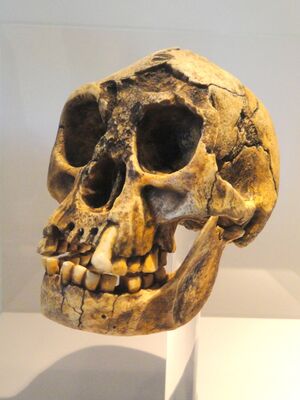
In addition to a small body size, H. floresiensis had a remarkably small brain size. LB1's brain is estimated to have had a volume of 380 cm3 (23 cu in), placing it at the range of chimpanzees or the extinct australopithecines.[1][48] LB1's brain size is less than half that of its presumed immediate ancestor, H. erectus (980 cm3 (60 cu in)).[48] The brain-to-body mass ratio of LB1 lies between that of H. erectus and the great apes.[75] Such a reduction is likely due to insular dwarfism, and a 2009 study found that the reduction in brain size of extinct pygmy hippopotamuses in Madagascar compared with their living relatives is proportionally greater than the reduction in body size, and similar to the reduction in brain size of H. floresiensis compared with H. erectus.[76]
Smaller size does not appear to have affected mental faculties, as Brodmann area 10 on the prefrontal cortex, which is associated with cognition, is about the same size as that of modern humans.[48] H. floresiensis is also associated with evidence for advanced behaviours, such as the use of fire, butchering, and stone tool manufacturing.[2][6]
Limbs
The angle of humeral torsion was lesser than in modern humans.[1][2][6] The humeral head of modern humans is twisted between 145 and 165 degrees to the plane of the elbow joint, whereas it is 120 degrees in H. floresiensis. This may have provided an advantage when arm-swinging, and, in tandem with the unusual morphology of the shoulder girdle and short clavicle, would have displaced the shoulders slightly forward into an almost shrugging position. The shrugging position would have compensated for the lower range of motion in the arm, allowing for similar maneuverability in the elbows as in modern humans.[77] The wrist bones are similar to those of apes and Australopithecus. They were significantly smaller and more flexible than the carpals of modern humans, lacking contemporary features which evolved at least 800,000 years ago.[78]
The leg bones were more robust than those of modern humans.[1][2][6] The feet were unusually flat and large in relation with the rest of the body.[79] As a result, when walking, they would have had to bend the knees further back than modern humans do. This caused a high-stepping gait and slow walking speed.[80] The toes were thin, long, and halluces were almost indistinguishable from the other metatarsals.[81]
Culture
The cave yielded over ten thousand stone artefacts, mainly lithic flakes, surprising considering H. floresiensis's small brain. This has led some researchers to theorize that H. floresiensis inherited their tool-making skills from H. erectus.[82] Points, perforators, blades, and microblades were associated with remains of the extinct elephant-relative Stegodon. It has therefore been proposed that H. floresiensis hunted juvenile Stegodon. Similar artefacts are found at the Soa Basin 50 km (31 mi) south, associated with Stegodon and Komodo dragon remains, and are attributed to a likely ancestral population of H. erectus.[1][2][6] Other authors have doubted the extent of hunting of Stegodon by H. floresiensis, noting the rarity of cut marks on remains of Stegodon found at Liang Bua, suggesting that they would have faced intense competition for carcasses with other predators, like the Komodo dragon, the giant stork Leptoptilos robustus, and vultures, and that it was possible that their main prey was instead the giant rats like Papagomys endemic to the island, which are found abundantly at Liang Bua. While it was initially suggested that H. floresiensis was capable of using fire, the supporting evidence for this claim was later found to be unreliable.[5]
Extinction
The youngest H. floresiensis bone remains in the cave date to 60,000 years ago, and the youngest stone tools to 50,000 years ago. The previous estimate of 12,000 BP was due to an undetected unconformity in the cave stratigraphy. The timing of their disappearance from the cave stratigraphy is close to the time that modern humans reached the area, which may suggest the effects of modern humans directly on H. floresiensis or more broadly on the ecosystems of Flores caused or contributed to their extinction.[83] DNA analysis of pygmy modern humans from Flores has found no evidence of any DNA from H. floresiensis.[84]
Paleoecology
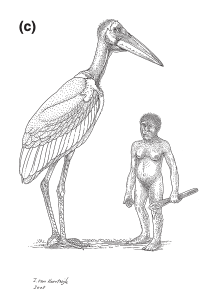
During the late Early Pleistocene to Late Pleistocene, and before the arrival of Homo sapiens, Flores exhibited a depauperate ecosystem with relatively few terrestrial vertebrate species, including the extinct dwarf proboscidean (elephant relative) Stegodon florensis;[4] and a variety of rats (Murinae) including small-sized forms like Rattus hainaldi, the Polynesian rat, Paulamys, and Komodomys, the medium-sized Hooijeromys, and giant Papagomys and extinct Spelaeomys, the latter two genera being about the size of rabbits, with body masses of 600–2،500 غرام (1.3–5.5 lb).[85] Also present were the Komodo dragon and another smaller monitor lizard (Varanus hooijeri),[4] with birds including a giant stork (Leptoptilos robustus) and a vulture (Trigonoceps).[86]
"Hobbit" nickname
Homo floresiensis was swiftly nicknamed "the hobbit" by the discoverers, after the fictional race popularized in J. R. R. Tolkien's book The Hobbit, and some of the discoverers suggested naming the species H. hobbitus.[15]
In October 2012, a New Zealand scientist due to give a public lecture on Homo floresiensis was told by the Tolkien Estate that he was not allowed to use the word "hobbit" in promoting the lecture.[87]
In 2012, the American film studio The Asylum, which produces low-budget "mockbuster" films,[88] planned to release a movie entitled Age of the Hobbits depicting a "peace-loving" community of H. floresiensis "enslaved by the Java Men, a race of flesh-eating dragon-riders."[89] The film was intended to piggyback on the success of Peter Jackson's film The Hobbit: An Unexpected Journey.[90] The film was blocked from release because of a legal dispute over the use of the word "hobbit."[90] The Asylum argued that the film did not violate the Tolkien copyright because the film was about H. floresiensis, "uniformly referred to as 'Hobbits' in the scientific community."[89] The film was finally released under its new title, Clash of the Empires.
See also
References
- ^ أ ب ت ث ج ح خ د ذ ر Brown, P.; et al. (27 October 2004). "A new small-bodied hominin from the Late Pleistocene of Flores, Indonesia" (PDF). Nature. 431 (7012): 1055–1061. Bibcode:2004Natur.431.1055B. doi:10.1038/nature02999. PMID 15514638. S2CID 26441.
- ^ أ ب ت ث ج ح خ د ذ ر ز Morwood, M. J.; et al. (13 October 2005). "Further evidence for small-bodied hominins from the Late Pleistocene of Flores, Indonesia". Nature. 437 (7061): 1012–1017. Bibcode:2005Natur.437.1012M. doi:10.1038/nature04022. PMID 16229067. S2CID 4302539.
- ^ أ ب Brumm, Adam; Jensen, Gitte M.; van den Bergh, Gert D.; Morwood, Michael J.; Kurniawan, Iwan; Aziz, Fachroel; Storey, Michael (2010). "Hominins on Flores, Indonesia, by one million years ago". Nature. 464 (7289): 748–752. Bibcode:2010Natur.464..748B. doi:10.1038/nature08844. ISSN 0028-0836. PMID 20237472. S2CID 205219871.
- ^ أ ب ت ث ج van den Bergh, Gerrit D.; Alloway, Brent V.; Storey, Michael; Setiawan, Ruly; Yurnaldi, Dida; Kurniawan, Iwan; Moore, Mark W.; Jatmiko; Brumm, Adam; Flude, Stephanie; Sutikna, Thomas; Setiyabudi, Erick; Prasetyo, Unggul W.; Puspaningrum, Mika R.; Yoga, Ifan (October 2022). "An integrative geochronological framework for the Pleistocene So'a basin (Flores, Indonesia), and its implications for faunal turnover and hominin arrival". Quaternary Science Reviews (in الإنجليزية). 294 107721. Bibcode:2022QSRv..29407721V. doi:10.1016/j.quascirev.2022.107721. hdl:10072/418777. S2CID 252290750.
- ^ أ ب ت ث ج ح خ Tocheri, Matthew W.; Sutikna, Thomas; Jatmiko; Saptomo, E. Wahyu (14 February 2022). "Homo floresiensis". The Oxford Handbook of Early Southeast Asia. Oxford University Press. pp. 38–69. doi:10.1093/oxfordhb/9780199355358.013.2. ISBN 978-0-19-935535-8. Retrieved 13 March 2023.
- ^ أ ب ت ث ج ح خ Morwood, M. J.; et al. (27 October 2004). "Archaeology and age of a new hominin from Flores in eastern Indonesia". Nature. 431 (7012): 1087–1091. Bibcode:2004Natur.431.1087M. doi:10.1038/nature02956. PMID 15510146. S2CID 4358548.
- ^ أ ب ت Sutikna, Thomas; Tocheri, Matthew W.; Morwood, Michael J.; et al. (30 March 2016). "Revised stratigraphy and chronology for Homo floresiensis at Liang Bua in Indonesia". Nature. 532 (7599): 366–369. Bibcode:2016Natur.532..366S. doi:10.1038/nature17179. PMID 27027286. S2CID 4469009.
- ^ Ritter, Malcolm (30 March 2016). "Study: Indonesia "hobbit" fossils older than first thought". Associated Press. Retrieved 1 April 2016.
- ^ Amos, Jonathan (30 March 2016). "Age of 'Hobbit' species revised". BBC News. Retrieved 1 April 2016.
- ^ أ ب ت ث ج Kaifu, Yousuke; Kurniawan, Iwan; Mizushima, Soichiro; Sawada, Junmei; Lague, Michael; Setiawan, Ruly; Sutisna, Indra; Wibowo, Unggul P.; Suwa, Gen; Kono, Reiko T.; Sasaki, Tomohiko; Brumm, Adam; van den Bergh, Gerrit D. (6 August 2024). "Early evolution of small body size in Homo floresiensis". Nature Communications (in الإنجليزية). 15 (1): 6381. Bibcode:2024NatCo..15.6381K. doi:10.1038/s41467-024-50649-7. ISSN 2041-1723. PMC 11303730. PMID 39107275.
{{cite journal}}: Check|pmc=value (help); Check|pmid=value (help) - ^ Jungers, W.; Baab, K. (December 2009). "The geometry of hobbits: Homo floresiensis and human evolution". Significance. 6 (4): 159–164. doi:10.1111/j.1740-9713.2009.00389.x.
- ^ Dalton, Rex (28 October 2004). "Little lady of Flores forces rethink of human evolution". Nature. 431 (7012): 1029. Bibcode:2004Natur.431.1029D. doi:10.1038/4311029a. PMID 15510116.
- ^ Morwood & Oosterzee 2007.
- ^ McKie, Robin (21 February 2010). "How a hobbit is rewriting the history of the human race". The Guardian. Retrieved 23 February 2010.
- ^ أ ب Aiello, Leslie C. (2010). "Five years of Homo floresiensis". American Journal of Physical Anthropology. 142 (2): 167–179. doi:10.1002/ajpa.21255. PMID 20229502.
- ^ Morwood, M. J.; Sutikna, T.; Saptomo, E. W.; Jatmiko; Hobbs, D. R.; Westaway, K. E. (November 2009). "Preface: research at Liang Bua, Flores, Indonesia". Journal of Human Evolution. 57 (5): 437–449. Bibcode:2009JHumE..57..437M. doi:10.1016/j.jhevol.2009.07.003. PMID 19733385.
- ^ Kaifu, Yousuke; Kono, Reiko T.; Sutikna, Thomas; Saptomo, E. Wahyu; Jatmiko; Rokus Due Awe; Baba, Hisao (2015). "Descriptions of the dental remains of Homo floresiensis". Anthropological Science. 123 (2): 129–145. doi:10.1537/ase.150501. Retrieved 20 June 2024.
- ^ Eckhardt, Robert B.; Chavanaves, Sakdapong; Henneberg, Maciej (April 2015). "Liang Bua Cave (Flores) humans (aka "Homo floresiensis") exhibit individual variation and temporal change, not uniformity and stasis" (PDF). American Journal of Physical Anthropology (84th Annual Meeting of the American Association of Physical Anthropologists, 25–28 March 2015) (156): 126–127. Retrieved 20 June 2024.
- ^ Marwick, Ben; Clarkson, Chris; O'Connor, Sue; Collins, Sophie (December 2016). "Early modern human lithic technology from Jerimalai, East Timor". Journal of Human Evolution. 101: 45–64. Bibcode:2016JHumE.101...45M. doi:10.1016/j.jhevol.2016.09.004. PMID 27886810.
- ^ Morwood & Oosterzee 2007, ch. 9.
- ^ أ ب Connor, Steve (30 November 2004). "'Hobbit woman' remains spark row among academics". New Zealand Herald. Archived from the original on 12 December 2004.
- ^ "Fight over access to 'hobbit' bones". Being human. New Scientist. 11 December 2004.
- ^ "Professor fuels row over 'hobbit man' fossils". The Times. London, UK. 3 December 2004. Archived from the original on 11 February 2007 – via timesonline.co.uk.
- ^ أ ب ت "'Hobbits' triumph tempered by tragedy". Sydney Morning Herald. Sydney, AU. 5 March 2005.
- ^ Powledge, Tabitha M. (28 February 2005). "Flores hominid bones returned". The Scientist. Retrieved 28 February 2009 – via the-scientist.com.
- ^ أ ب ت "'Hobbit' cave digs set to restart". Science. BBC News. British Broadcasting Corporation. 25 January 2007 – via news.bbc.co.uk.
- ^ Culotta, E. (2005). "New 'hobbits' bolster species, but origins still a mystery" (PDF). Paleoanthropology. Science. Vol. 310, no. 5746. pp. 208–209. Retrieved 20 June 2024.
- ^ Morwood & Oosterzee 2007, ch. 9.
- ^ Dennell, Robin W.; Louys, Julien; O'Regan, Hannah J.; Wilkinson, David M. (July 2014). "The origins and persistence of Homo floresiensis on Flores: biogeographical and ecological perspectives". Quaternary Science Reviews (in الإنجليزية). 96: 98–107. Bibcode:2014QSRv...96...98D. doi:10.1016/j.quascirev.2013.06.031. hdl:1885/30501. S2CID 56035748.
- ^ Callaway, E. (8 June 2016). "'Hobbit' relatives found after ten-year hunt". Nature. 534 (7606): 164–165. Bibcode:2016Natur.534Q.164C. doi:10.1038/534164a. PMID 27279191.
- ^ Brumm, A.; van den Bergh, G. D.; Storey, M.; Kurniawan, I.; Alloway, B. V.; Setiawan, R.; Setiyabudi, E.; Grün, R.; Moore, M. W.; Yurnaldi, D.; Puspaningrum, M. R.; Wibowo, U. P.; Insani, H.; Sutisna, I.; Westgate, J. A.; Pearce, N. J. G.; Duval, M.; Meijer, H. J. M.; Aziz, F.; Sutikna, T.; van der Kaars, S.; Flude, S.; Morwood, M. J. (8 June 2016). "Age and context of the oldest known hominin fossils from Flores" (PDF). Nature. 534 (7606): 249–253. Bibcode:2016Natur.534..249B. doi:10.1038/nature17663. PMID 27279222. S2CID 28608179.
- ^ van den Bergh, G. D.; Kaifu, Y.; Kurniawan, I.; Kono, R. T.; Brumm, A.; Setiyabudi, E.; Aziz, F.; Morwood, M. J. (8 June 2016). "Homo floresiensis-like fossils from the early Middle Pleistocene of Flores". Nature. 534 (7606): 245–248. Bibcode:2016Natur.534..245V. doi:10.1038/nature17999. PMID 27279221. S2CID 205249218.
- ^ أ ب Jungers, W. L.; Harcourt-Smith, W. E. H.; Wunderlich, R. E.; Tocheri, M. W.; Larson, S. G.; Sutikna, T.; Due, Rhokus Awe; Morwood, M. J. (2009). "The foot of Homo floresiensis". Nature. 459 (7243): 81–84. Bibcode:2009Natur.459...81J. doi:10.1038/nature07989. PMID 19424155. S2CID 4392759.
- ^ أ ب Argue, Debbie; Morwood, M.; Sutikna, T.; Jatmiko; Saptomo, W. (July 2009). "Homo floresiensis: A cladistic analysis". Journal of Human Evolution. Online Only as of Aug 4, 2009 (5): 623–639. Bibcode:2009JHumE..57..623A. doi:10.1016/j.jhevol.2009.05.002. PMID 19628252.
- ^ أ ب Dembo, M.; Matzke, N. J.; Mooers, A. Ø.; Collard, M. (2015). "Bayesian analysis of a morphological supermatrix sheds light on controversial fossil hominin relationships". Proceedings of the Royal Society B: Biological Sciences. 282 (1812) 20150943. doi:10.1098/rspb.2015.0943. PMC 4528516. PMID 26202999.
the data we currently have for H. floresiensis are unable to distinguish among the various 'hobbits are early hominins' hypotheses
- ^ أ ب Argue, Debbie; Groves, Colin P. (21 April 2017). "The affinities of Homo floresiensis based on phylogenetic analyses of cranial, dental, and postcranial characters". Journal of Human Evolution. 107: 107–133. Bibcode:2017JHumE.107..107A. doi:10.1016/j.jhevol.2017.02.006. PMID 28438318.
Support for most clades in all analyses was rather low as measured by traditional methods (bootstrap and Bremer support in parsimony, posterior probability in Bayesian inference)
- ^ أ ب Trueman, John W.H. (August 2010). "A new cladistic analysis of Homo floresiensis". Journal of Human Evolution (in الإنجليزية). 59 (2): 223–226. Bibcode:2010JHumE..59..223T. doi:10.1016/j.jhevol.2010.01.013. PMID 20494404.
- ^ Dembo, Mana; Radovčić, Davorka; Garvin, Heather M.; Laird, Myra F.; Schroeder, Lauren; Scott, Jill E.; Brophy, Juliet; Ackermann, Rebecca R.; Musiba, Chares M.; de Ruiter, Darryl J.; Mooers, Arne Ø.; Collard, Mark (August 2016). "The evolutionary relationships and age of Homo naledi: An assessment using dated Bayesian phylogenetic methods". Journal of Human Evolution (in الإنجليزية). 97: 17–26. Bibcode:2016JHumE..97...17D. doi:10.1016/j.jhevol.2016.04.008. hdl:2164/8796. PMID 27457542.
- ^ Berger, L. R.; Churchill, S. E.; et al. (2008). "Small-Bodied Humans from Palau, Micronesia". PLOS ONE. 3 (3) e1780. Bibcode:2008PLoSO...3.1780B. doi:10.1371/journal.pone.0001780. PMC 2268239. PMID 18347737.
- ^ أ ب ت Kaifu, Yousuke; Kono, Reiko T.; Sutikna, Thomas; Saptomo, Emanuel Wahyu; Jatmiko; Due Awe, Rokus (18 November 2015). Bae, Christopher (ed.). "Unique Dental Morphology of Homo floresiensis and Its Evolutionary Implications". PLoS One. 10 (11) e0141614. Bibcode:2015PLoSO..1041614K. doi:10.1371/journal.pone.0141614. PMC 4651360. PMID 26624612.
- ^ أ ب Zanolli, Clément; Kaifu, Yousuke; Pan, Lei; Xing, Song; Mijares, Armand S.; Kullmer, Ottmar; Schrenk, Friedemann; Corny, Julien; Dizon, Eusebio; Robles, Emil; Détroit, Florent (February 2022). "Further analyses of the structural organization of Homo luzonensis teeth: Evolutionary implications". Journal of Human Evolution (in الإنجليزية). 163 103124. Bibcode:2022JHumE.16303124Z. doi:10.1016/j.jhevol.2021.103124. PMID 34998272. S2CID 245784713.
- ^ أ ب Kaifu, Yousuke (1 December 2017). "Archaic Hominin Populations in Asia before the Arrival of Modern Humans: Their Phylogeny and Implications for the "Southern Denisovans"". Current Anthropology (in الإنجليزية). 58 (S17): S418–S433. doi:10.1086/694318. ISSN 0011-3204.
- ^ Zeitoun, Valéry; Barriel, Véronique; Widianto, Harry (April 2016). "Phylogenetic analysis of the calvaria of Homo floresiensis". Comptes Rendus Palevol (in الإنجليزية). 15 (5): 555–568. Bibcode:2016CRPal..15..555Z. doi:10.1016/j.crpv.2015.12.002.
- ^ Matsu’ura, Shuji; Kondo, Megumi; Danhara, Tohru; Sakata, Shuhei; Iwano, Hideki; Hirata, Takafumi; Kurniawan, Iwan; Setiyabudi, Erick; Takeshita, Yoshihiro; Hyodo, Masayuki; Kitaba, Ikuko; Sudo, Masafumi; Danhara, Yugo; Aziz, Fachroel (10 January 2020). "Age control of the first appearance datum for Javanese Homo erectus in the Sangiran area". Science (in الإنجليزية). 367 (6474): 210–214. Bibcode:2020Sci...367..210M. doi:10.1126/science.aau8556. ISSN 0036-8075. PMID 31919224.
- ^ Husson, Laurent; Salles, Tristan; Lebatard, Anne-Elisabeth; Zerathe, Swann; Braucher, Régis; Noerwidi, Sofwan; Aribowo, Sonny; Mallard, Claire; Carcaillet, Julien; Natawidjaja, Danny H.; Bourlès, Didier; ASTER team; Aumaitre, Georges; Bourlès, Didier; Keddadouche, Karim (8 November 2022). "Javanese Homo erectus on the move in SE Asia circa 1.8 Ma". Scientific Reports (in الإنجليزية). 12 (1): 19012. Bibcode:2022NatSR..1219012H. doi:10.1038/s41598-022-23206-9. ISSN 2045-2322. PMC 9643487. PMID 36347897.
- ^ Jones, Cheryl (5 January 2011). "Researchers to drill for hobbit history : Nature News". Nature. doi:10.1038/news.2011.702. Retrieved 1 October 2011.
- ^ Falk, D.; Hildebolt, Charles; Smith, Kirk; Morwood, M.J.; Sutikna, Thomas; Jatmiko; Saptomo, E. Wayhu; Prior, Fred (2009). "LB1's virtual endocast, microcephaly and hominin brain evolution". Journal of Human Evolution. 57 (5): 597–607. Bibcode:2009JHumE..57..597F. doi:10.1016/j.jhevol.2008.10.008. PMID 19254807.
- ^ أ ب ت ث Falk, D.; et al. (8 April 2005). "The Brain of LB1, Homo floresiensis" (PDF). Science. 308 (5719): 242–245. Bibcode:2005Sci...308..242F. doi:10.1126/science.1109727. PMID 15749690. S2CID 43166136.
- ^ Weber, J.; Czarnetzki, A.; Pusch, C.M. (14 October 2005). "Comment on "The Brain of LB1, Homo floresiensis"". Science. 310 (5746): 236. doi:10.1126/science.1114789. PMID 16224005.
- ^ von Bredow, Rafaela (1 September 2006). "Indonesia's "Hobbit": A Huge Fight over a Little Man". Der Spiegel.
- ^ أ ب ت ث Jacob, T.; Indriati, E.; Soejono, R. P.; Hsu, K.; Frayer, D. W.; Eckhardt, R. B.; Kuperavage, A. J.; Thorne, A.; Henneberg, M. (5 September 2006). "Pygmoid Australomelanesian Homo sapiens skeletal remains from Liang Bua, Flores: Population affinities and pathological abnormalities". Proceedings of the National Academy of Sciences of the United States of America. 103 (36): 13421–13426. Bibcode:2006PNAS..10313421J. doi:10.1073/pnas.0605563103. PMC 1552106. PMID 16938848.
- ^ أ ب Argue, D.; Donlon, D.; Groves, C.; Wright, R. (October 2006). "Homo floresiensis: Microcephalic, pygmoid, Australopithecus, or Homo?". Journal of Human Evolution. 51 (4): 360–374. Bibcode:2006JHumE..51..360A. doi:10.1016/j.jhevol.2006.04.013. PMID 16919706.
- ^ Falk, D.; Hildebolt, C.; Smith, K.; Morwood, M. J.; Sutikna, T. (2 February 2007). "Brain shape in human microcephalics and Homo floresiensis". Proceedings of the National Academy of Sciences. 104 (7): 2513–8. Bibcode:2007PNAS..104.2513F. doi:10.1073/pnas.0609185104. PMC 1892980. PMID 17277082.
- ^ أ ب Lyras, G.A.; Dermitzakis, D.M.; Van Der Geer, A.A.E.; Van der Geer, S.B.; De Vos, J. (1 August 2008). "The origin of Homo floresiensis and its relation to evolutionary processes under isolation". Anthropological Science. 117: 33–43. doi:10.1537/ase.080411. Retrieved 20 June 2024.
- ^ Vannucci, Robert C.; Barron, Todd F.; Holloway, Ralph L. (2013). "Frontal Brain Expansion During Development Using MRI and Endocasts: Relation to Microcephaly and Homo floresiensis". The Anatomical Record. 296 (4): 630–637. doi:10.1002/ar.22663. ISSN 1932-8486. PMID 23408553.
- ^ Balzeau, Antoine; Charlier, Philippe (2016). "What do cranial bones of LB1 tell us about Homo floresiensis?". Journal of Human Evolution. 93: 12–24. Bibcode:2016JHumE..93...12B. doi:10.1016/j.jhevol.2015.12.008. ISSN 0047-2484. PMID 27086053.
- ^ Hershkovitz, Israel; Kornreich, Liora; Laron, Zvi (2007). "Comparative skeletal features between Homo floresiensis and patients with primary growth hormone insensitivity (Laron syndrome)". American Journal of Physical Anthropology. 134 (2): 198–208. doi:10.1002/ajpa.20655. ISSN 0002-9483. PMID 17596857.
- ^ Obendorf, P.J.; Oxnard, C.E.; Kefford, C.E. (7 June 2008). "Are the small human-like fossils found on Flores human endemic cretins?". Proceedings of the Royal Society B. 275 (1640): 1287–1296. doi:10.1098/rspb.2007.1488. PMC 2602669. PMID 18319214.
- ^ Baab, Karen L. (2012). "Homo floresiensis: Making Sense of the Small-Bodied Hominin Fossils from Flores". Nature Education Knowledge. Learn Science at Scitable. Vol. 3, no. 9. p. 4. Retrieved 20 June 2024.
- ^ Groves, Colin Peter; Fitzgerald, Catharine (2010). "Healthy hobbits or victims of Sauron". Homo: Journal of Comparative Human Biology. 61 (3): 211. doi:10.1016/j.jchb.2010.01.019.
- ^ "Flores hobbits didn't suffer from cretinism". New Scientist. 206 (2766): 17. 2010. doi:10.1016/S0262-4079(10)61537-0. ISSN 0262-4079.
- ^ Oxnard, C.; Obendorf, P.J.; Kefford, B.B. (2010). "Post-cranial skeletons of hypothyroid cretins show a similar anatomical mosaic as Homo floresiensis". PLOS ONE. 5 (9) e13018. Bibcode:2010PLoSO...513018O. doi:10.1371/journal.pone.0013018. PMC 2946357. PMID 20885948.
- ^ Brown, Peter (2012). "LB1 and LB6 Homo floresiensis are not modern human (Homo sapiens) cretins". Journal of Human Evolution. 62 (2): 201–224. Bibcode:2012JHumE..62..201B. doi:10.1016/j.jhevol.2011.10.011. ISSN 0047-2484. PMID 22277102.
- ^ Henneberg, Maciej; Eckhardt, Robert B.; Chavanaves, Sakdapong; Hsü, Kenneth J. (5 August 2014). "Evolved developmental homeostasis disturbed in LB1 from Flores, Indonesia, denotes Down syndrome and not diagnostic traits of the invalid species Homo floresiensis". Proceedings of the National Academy of Sciences. 111 (31): 11967–11972. Bibcode:2014PNAS..11111967H. doi:10.1073/pnas.1407382111. PMC 4143021. PMID 25092311.
- ^ Westaway, Michel Carrington; Durband, Arthur C. C; Groves, Colin P.; Collard, Mark (17 February 2015). "Mandibular evidence supports Homo floresiensis as a distinct species". Proceedings of the National Academy of Sciences. 112 (7): E604–E605. Bibcode:2015PNAS..112E.604W. doi:10.1073/pnas.1418997112. PMC 4343145. PMID 25659745.
- ^ Baab, Karen (8 June 2016). "A Critical Evaluation of the Down Syndrome Diagnosis for LB1, Type Specimen of Homo floresiensis". PLOS ONE. 11 (6) e0155731. Bibcode:2016PLoSO..1155731B. doi:10.1371/journal.pone.0155731. PMC 4898715. PMID 27275928.
- ^ Stringer 2011, p. 82.
- ^ Tattersall 2015, p. 194.
- ^ "Pygmy". Encyclopædia Britannica. Archived from the original on 8 January 2008.
- ^ Fix, Alan G. (June 1995). "Malayan Paleosociology: Implications for Patterns of Genetic Variation among the Orang Asli". American Anthropologist. New Series. 97 (2): 313–323. doi:10.1525/aa.1995.97.2.02a00090. JSTOR 681964.
- ^ Weber, George. "5. A Physical Examination". The Andamanese. andaman.org. Archived from the original on 10 July 2012. Retrieved 1 October 2011.
- ^ "Hobbit-Like Human Ancestor Found in Asia". nationalgeographic.com (in الإنجليزية). National Geographic News. 27 October 2004. Archived from the original on 5 September 2019. Retrieved 22 May 2020.
- ^ Van Den Bergh, G. D.; Rokhus Due Awe; Morwood, M. J.; Sutikna, T.; Jatmiko; Wahyu Saptomo, E. (May 2008). "The youngest Stegodon remains in Southeast Asia from the Late Pleistocene archaeological site Liang Bua, Flores, Indonesia". Quaternary International. 182 (1): 16–48. Bibcode:2008QuInt.182...16V. doi:10.1016/j.quaint.2007.02.001.
- ^ Tucci, S.; et al. (3 August 2018). "Evolutionary history and adaptation of a human pygmy population of Flores Island, Indonesia". Science. 361 (6401): 511–516. Bibcode:2018Sci...361..511T. doi:10.1126/science.aar8486. PMC 6709593. PMID 30072539.
- ^ Falk, D.; et al. (19 May 2006). "Response to Comment on 'The Brain of LB1, Homo floresiensis'". Science. 312 (5776): 999c. doi:10.1126/science.1124972.
- ^ Weston, E. M.; Lister, A. M. (7 May 2009). "Insular dwarfism in hippos and a model for brain size reduction in Homo floresiensis". Nature. 459 (7243): 85–88. Bibcode:2009Natur.459...85W. doi:10.1038/nature07922. ISSN 0028-0836. PMC 2679980. PMID 19424156.
- ^ Larson et al. 2007.
- ^ Tocheri, M.W.; Orr, C.M.; Larson, S.G.; Sutikna, T.; Jatmiko; Saptomo, E.W.; Due, R.A.; Djubiantono, T.; Morwood, M.J.; Jungers, W.L. (21 September 2007). "The Primitive Wrist of Homo floresiensis and Its Implications for Hominin Evolution" (PDF). Science. 317 (5845): 1743–5. Bibcode:2007Sci...317.1743T. doi:10.1126/science.1147143. PMID 17885135. S2CID 42081240.
- ^ Jungers, William L.; Larson, S.G.; Harcourt-Smith, W.; Morwood, M.J.; Sutikna, T.; Due Awe, Rokhus; Djubiantono, T. (4 December 2008). "Descriptions of the lower limb skeleton of Homo floresiensis". Journal of Human Evolution. 57 (5): 538–554. doi:10.1016/j.jhevol.2008.08.014. PMID 19062072.
- ^ Blaszczyk, Maria B.; Vaughan, Christopher L. (2007). "Re-interpreting the evidence for bipedality in Homo floresiensis". South African Journal of Science. 103 (103): 103.
- ^ Callaway, Ewen (16 April 2008). "Flores 'hobbit' walked more like a clown than Frodo". New Scientist. Vol. 3. pp. 983–984.
- ^ Moore, Mark. "How the Homo floresiensis kept their tools as they shrank into island life". phys.org. The Conversation. Retrieved 2 December 2022.
- ^ Callaway, E. (30 March 2016). "Did humans drive 'hobbit' species to extinction?". Nature. doi:10.1038/nature.2016.19651. S2CID 87482781.
- ^ Tucci, Serena; Vohr, Samuel H.; McCoy, Rajiv C.; Vernot, Benjamin; Robinson, Matthew R.; Barbieri, Chiara; Nelson, Brad J.; Fu, Wenqing; Purnomo, Gludhug A.; Sudoyo, Herawati; Eichler, Evan E.; Barbujani, Guido; Visscher, Peter M.; Akey, Joshua M.; Green, Richard E. (August 2018). "Evolutionary history and adaptation of a human pygmy population of Flores Island, Indonesia". Science. 361 (6401): 511–516. Bibcode:2018Sci...361..511T. doi:10.1126/science.aar8486. PMC 6709593. PMID 30072539.
- ^ Veatch, E. Grace; Tocheri, Matthew W.; Sutikna, Thomas; McGrath, Kate; Wahyu Saptomo, E.; Jatmiko; Helgen, Kristofer M. (May 2019). "Temporal shifts in the distribution of murine rodent body size classes at Liang Bua (Flores, Indonesia) reveal new insights into the paleoecology of Homo floresiensis and associated fauna". Journal of Human Evolution (in الإنجليزية). 130: 45–60. Bibcode:2019JHumE.130...45V. doi:10.1016/j.jhevol.2019.02.002. hdl:2440/121139. PMID 31010543.
- ^ Meijer, Hanneke J. M.; Sutikna, Thomas; Wahyu Saptomo, E.; Tocheri, Matthew W. (July 2022). "More bones of Leptoptilos robustus from Flores reveal new insights into giant marabou stork paleobiology and biogeography". Royal Society Open Science (in الإنجليزية). 9 (7) 220435. Bibcode:2022RSOS....920435M. doi:10.1098/rsos.220435. ISSN 2054-5703. PMC 9277297. PMID 35845853.
- ^ Lee, Julian (24 أكتوبر 2012). "Hobbit makers ban uni from using 'hobbit'". 3 News NZ. Archived from the original on 7 يونيو 2013. Retrieved 29 أكتوبر 2013.
- ^ Somma, Brandon (4 January 2013). "Masters of the Mockbuster:What The Asylum Is All About". the-artifice.com. The Artifice. Retrieved 20 June 2024.
- ^ أ ب "The Hobbit producers sue 'mockbuster' film company". BBC. 8 November 2012. Retrieved 20 June 2024.
- ^ أ ب Fritz, Ben (10 December 2012). "'Hobbit' knockoff release blocked by judge". Los Angeles Times. Retrieved 11 December 2012.
Bibliography
- Larson, Susan G.; Jungers, William L.; Morwood, Michael J.; Sutikna, Thomas; Jatmiko; Saptomo, E. Wahyu; Due, Rokus Awe; Djubiantono, Tony (December 2007). "Homo floresiensis and the evolution of the hominin shoulder" (PDF). Journal of Human Evolution. 53 (6): 718–31. Bibcode:2007JHumE..53..718L. doi:10.1016/j.jhevol.2007.06.003. PMID 17692894. Archived from the original (PDF) on 13 June 2011.
- Morwood, Mike; Oosterzee, Penny van (2007). A New Human: The Startling Discovery and Strange Story of the "Hobbits" of Flores, Indonesia. Smithsonian Books. ISBN 978-0-06-089908-0.
- Stringer, Chris (2011). The Origin of Our Species. London: Allen Lane. ISBN 978-1-84614-140-9.
- Tattersall, Ian (2015). The Strange Case of the Rickety Cossack and other Cautionary Tales from Human Evolution. Palgrave Macmillan. ISBN 978-1-137-27889-0.
Further reading
- Falk, Dean (2011). The Fossil Chronicles: How Two Controversial Discoveries Changed Our View of Human Evolution. University of California Press. ISBN 978-0-520-26670-4.
- Martin, R. D.; MacLarnon, A. M.; Phillips, J. L.; Dussubieux, L.; Williams, P. R.; Dobyns, W. B. (19 May 2006). "Comment on "The Brain of LB1, Homo floresiensis"". Science. 312 (5776): 999. Bibcode:2006Sci...312.....M. doi:10.1126/science.1121144. PMID 16709768.
External links
- Hawks, John. Blog of a professor of anthropology who closely follows this topic.
- "Another diagnosis for a hobbit". 3 July 2007. Archived from the original on 18 July 2007.
- "The Liang Bua report". 10 August 2007. Archived from the original on 18 July 2007.
- "The forelimb and hindlimb remains from Liang Bua cave". 18 December 2008. Archived from the original on 27 December 2008.
- "Hominin remains from Mata Menge, Flores". 8 June 2016. Archived from the original on 13 June 2016.
- "Scientific American Interview with Professor Brown". sciam.com. 27 October 2004. Retrieved 20 June 2024.
- Mayell, Hillary (27 October 2004). ""Hobbit" Discovered: Tiny Human Ancestor Found in Asia". National Geographic News. Archived from the original on 29 October 2004. Retrieved 20 June 2024.
- "Homo floresiensis". humanorigins.si.edu. The Smithsonian Institution's Human Origins Program. July 2022. Retrieved 20 June 2024.
- Obendorf, Peter; Oxnard, Charles E.; Kefford, Ben J. (5 March 2008). "Were Homo floresiensis just a population of myxoedematous endemic cretin Homo sapiens?". Proceedings of the Royal Society B: Biological Sciences (blog commentary on the Obendorf paper). -1 (–1): –1. Archived from the original on 12 January 2013.
- "Virtual Endocasts of the "Hobbit"". erl.wustl.edu. Washington University in St. Louis, Electronic Radiology Laboratory. Archived from the original on 15 December 2012.
- Purdy, Michael C. (3 March 2005). "'Hobbit' fossil likely represents new branch on human family tree" (source.wustl.edu). Washington University in St. Louis. Retrieved 20 June 2024.
- "Alien from Earth". pbs.org (Nova's documentary website, complete program available through Watch Online feature). Retrieved 20 June 2024.
- "Hobbits in the Haystack: Homo floresiensis and Human Evolution". turkanabasin.org (Turkhana Basin Institute presentation at the Seventh Stony Brook Human Evolution Symposium). 21 April 2009. Retrieved 20 June 2024.
- "Human Timeline (Interactive)". humanorigins.si.edu. Smithsonian, National Museum of Natural History. August 2016.
- CS1 errors: PMC
- CS1 errors: PMID
- Short description is different from Wikidata
- Articles with hatnote templates targeting a nonexistent page
- Missing redirects
- Automatic taxobox cleanup
- 2003 archaeological discoveries
- Early species of Homo
- Pleistocene primates
- Prehistoric Indonesia
- Fossil taxa described in 2004
- Flores Island (Indonesia)
- Extinct animals of Indonesia
- Pleistocene mammals of Asia
